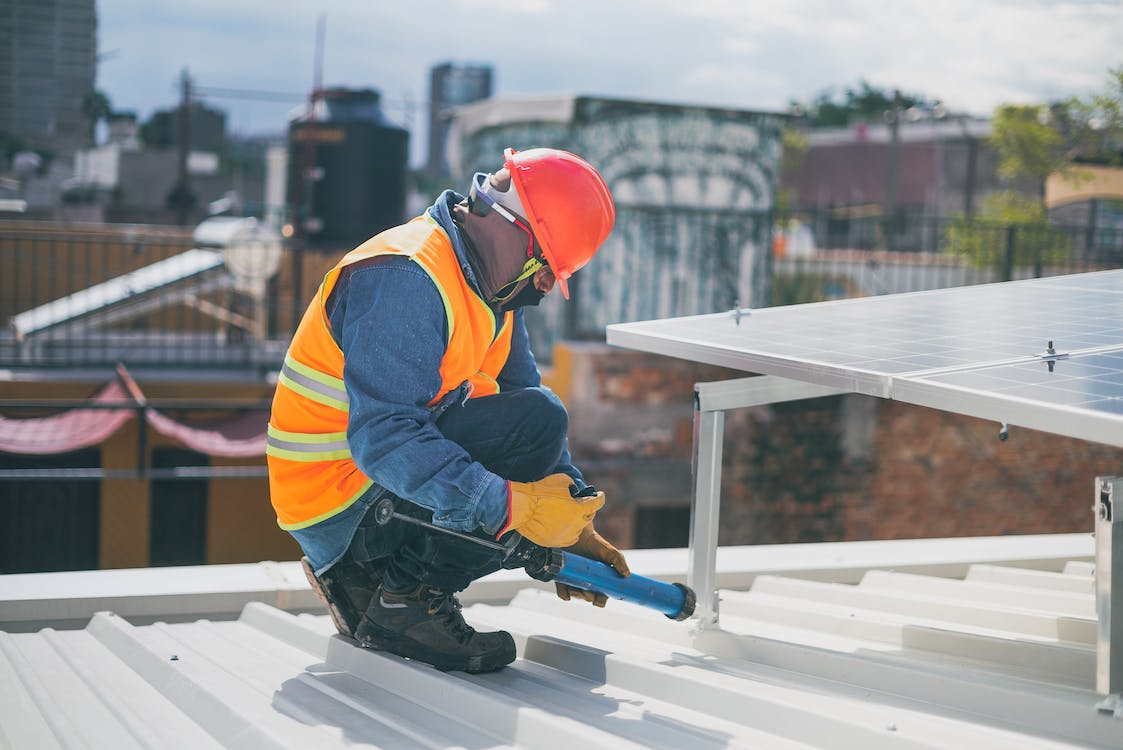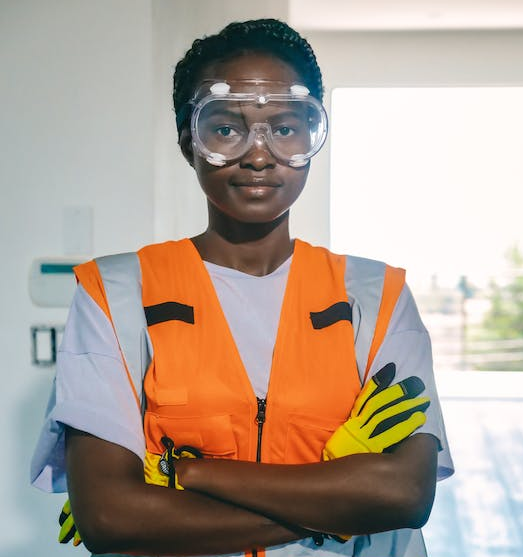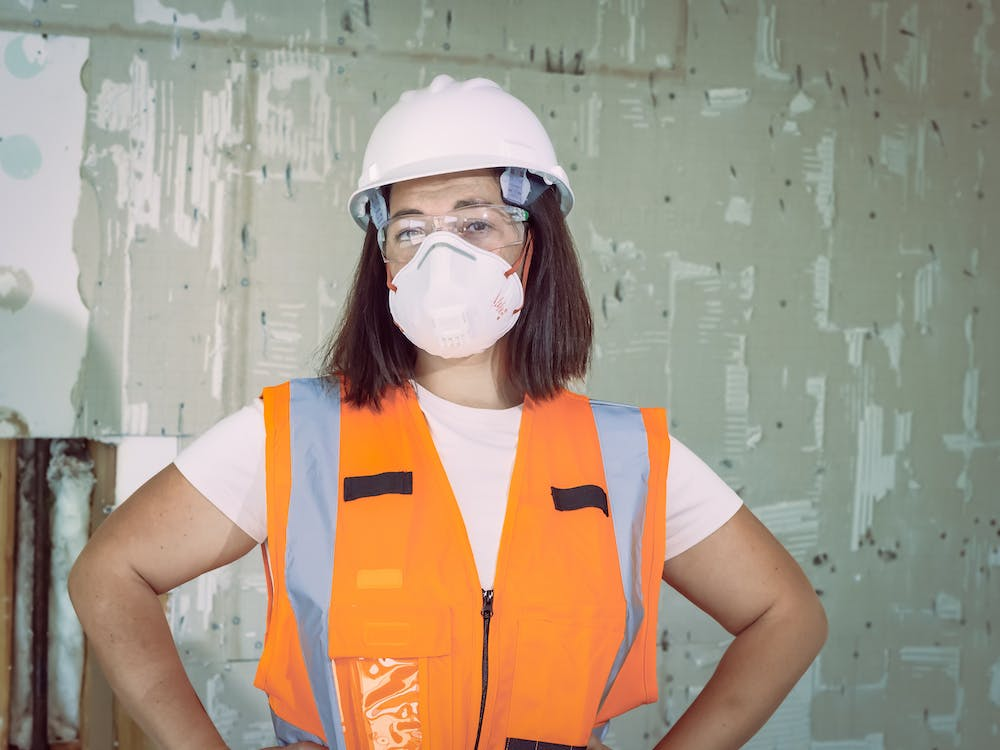Heavy-duty industry workers need to be especially cautious about eye injuries. These can happen for various reasons unique to these industries, like flying debris, metal fragments, wood chips, or concrete pieces produced during operations like welding, grinding, or cutting. Chemical splashes from dangerous liquids or caustic chemicals also present a serious risk.
Intense light and UV radiation from lasers or welding arcs can also harm the eyes. These injuries are caused in part by failure to use proper eye protection, insufficient training, and a lack of danger awareness. That’s why it’s imperative to address these reasons by implementing appropriate safety measures, such as obligatory eye protection and extensive training programs.
Here are some critical interventions you can take toward preventing eye injuries.
1. Mandatory Use of Personal Protective Equipment (PPE)
The first and most crucial step in preventing eye injuries on construction sites is ensuring the use of personal protective equipment (PPE). The most important and initial step in minimizing eye injuries on construction sites is requiring the use of personal protective equipment (PPE). Workers must wear the proper safety glasses or goggles as part of their required PPE.
Safety goggles give proper coverage and protection against chemical splashes, while safety glasses with side shields offer efficient defense against flying dust and debris. Construction sites create a systematic and proactive approach to reducing the risk of eye injuries by mandating the use of eye protection.
2. Conduct Hazard Assessments
Hazard evaluations conducted regularly are essential to preventing eye injuries on job sites. Regularly checking the workplace for potential eye dangers is crucial. This entails locating places with flying debris, large concentrations of chemicals or dust, or powerful light sources.
Construction supervisors can install proper eye protection measures and proactive actions to reduce risks by identifying these dangers. Hazard analyses assist in identifying specific work environments and tasks where employees are more likely to sustain eye injuries, enabling more focused prevention measures.
3. Provide Training and Education
All employees should receive thorough instructions on eye safety and how to use and maintain eye protection. Training sessions should go through potential hazards, the necessity of eye protection, and ways to spot potential eye injury threats.
Construction sites equip their employees with the knowledge and abilities they need, so they may actively safeguard their eyes and avoid accidents. Regular refresher training sessions and awareness campaigns further emphasize the need for eye protection.
4. Implement Engineering Controls
Implementing technical controls to minimize eye injury hazards on building sites is another method of preventing eye injuries. Engineering controls should be used whenever possible on building sites to eliminate or minimize eye dangers. Installing security barriers or screens, for instance, can stop flying debris from hitting employees’ eyes.
The amount of dust in the air in the work area can be decreased using dust management solutions like ventilation or water suppression. Engineering controls supplement wearing personal protective equipment by addressing dangers at the source and improving overall eye safety.
5. Regular Equipment Inspections
Tools that aren’t working properly can produce projectiles or release dangerous substances, harming the eyes of workers. Construction sites can quickly identify possible problems and take appropriate action by putting in place a comprehensive maintenance program and performing routine equipment inspections.
Tools like saws, grinders, and nail guns should all be inspected to make sure they are in good operating order and can effectively prevent eye injuries from occurring.
6. Provide Proper Lighting
Proper illumination is crucial to lessen eye strain and improve vision on construction sites. The likelihood of eye injuries is decreased since workers can better identify and respond to harmful situations thanks to adequate illumination.
All work locations on construction sites need adequate lighting, especially those where precise activities are carried out. An additional benefit of good lighting is that it lessens the need for harsh artificial sources of light, which may be uncomfortable and taxing on the eyes.
7. Establish Clear Safety Procedures
On any job site where workers perform their tasks, following clear safety rules is essential to preventing eye injuries. Managers of construction sites should create and implement specific safety measures for eye protection. These protocols should cover how to use eye protection, handle dangerous materials, report probable eye injuries, and deal with them.
A strong safety culture with an emphasis on eye safety is maintained through regular interactions and reinforcing safety practices through toolbox discussions, safety meetings, and signage.
8. Regular Safety Audits and Reviews
Finally, to prevent eye injuries while working on a job site, routine safety checks and inspections play an important role in keeping everyone safe. Periodic audits assist in finding any gaps or flaws in eye safety procedures and enable prompt corrective action. Eye safety measures are kept current through routine assessments of security protocols and practices based on new risks, laws, or industry best practices.
It is also vital to get workers’ opinions since they can offer insightful information on potential risks and recommendations for improvement. To increase eye safety and safeguard workers from harm, building sites should promote a culture of continual development.
For those of you employed within a heavy-duty industry where your work takes you to confined spaces or dangerous heights, you will need to undergo mandatory training to learn how to respond to crises and to promote safe working protocols.
That’s why our experts at Metro Safety offer confined space and fall protection training to those looking to gain more expertise and insight into how best to protect yourself and your crew members. You can also check out our extensive occupational first aid courses to learn life-saving skills to apply on-site.










